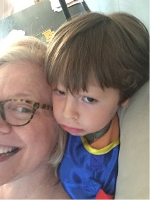IPA Executive Board members have been invited to write blog posts for the Importance of Play blog from TIE (Toy Industry of Europe). Recently IPA Communications Officer Cynthia Gentry contributed one on play and creativity. It is reproduced here, but can be found in its entirety at: http://importanceofplay.eu/blog/article/play-and-creativity
by Cynthia Gentry

How can you ensure that children are creative?
Get out of the way and let them play as they choose.
My four-year-old grandson loves to draw the wind with pink and green crayons. When I first noticed this I asked him to tell me what those squiggly little lines on his paper were. He stopped drawing and looked closely into my eyes as if attempting to discover what was wrong with me. He couldn’t understand how I could not see. Luckily, I completely understood when he held a bath towel to his shoulders and ran to let the wind lift his cape so he could fly. It wasn’t all that long ago that I, too, could fly.
Upon reading this paragraph you know that what is being described is both play and creativity coexisting in the same fruitful young mind of my grandson. Creativity. Imagination. Pretend. All words that overlap and all words that live comfortably and symbiotically with play. Creativity is something you just know when you see it. Play, if you really can remember it, is something you just feel when you do it. And, if you can remember, you remember that play came from within you. It was not something you were instructed to do. You made it up as you went along, and that was and is the source of much of its power and magic.
Evidence shows that children who play grow into more creative adults than children who do not play. There are many, many benefits of the free, self-directed play of a child, and enhanced creativity is just one, but it is a critical one. Creativity is more than just the ability to paint a beautiful picture, write a compelling screenplay, or design an awe-inspiring building, even though these are all good examples of it. From creative inspiration will come the future of our world (if we are lucky), and the more thriving minds we have the better able we will be to solve the ever-increasing and difficult challenges ahead. The topics of creativity and “the creative class” come up often in discussions of the future of business, education, urban design, medicine, technology, climate change, sustainability and so on. International focus on design in most industries clearly reveals an expanded understanding of the importance of creative and innovative thought.
So, the value of creativity is clearly understood. Yet, it is said that in many countries we are educating our children for the way things used to be, instead of for the way things will be. The general consensus in these places is that achievements and learning are vastly more important than something as seemingly frivolous as play, and that good test scores are more important than something like creativity. Yet, by trying to make our children more productive, we are cutting off the very thing that develops the ability to produce something of more value. We totally miss the point that creativity is innate and that play preserves and protects it and, most importantly, strengthens it and helps it flourish. Perhaps we should be letting children play like we used to play – without an end result in mind, without a motive or plan. Perhaps we should let them play just because it makes for a life well lived.
It is well documented that the amount of time children spend playing is decreasing, and with it, creativity has been decreasing as well. This is hardly a coincidence. The two are linked. A lot of the blame has been put on electronics. A study in the United States by the Kaiser Family Foundation indicated that the average child spends over seven hours a day engaged with some device, be it the television, computer, or smart phone. Another powerful reason for the declines is that adults do not understand what they are doing by not creating a world that supports children’s play.
Convincing “grown-ups” of the importance of play and creativity proves to be difficult and that reveals a dangerous lack of understanding. We worry that our children are wasting valuable time. We worry that they won’t be successful. We push for more classes, more studying. Children don’t outgrow creativity, instead the heavily structured and regulated environments we have created for them in school and beyond have shut down their curiosity and imaginations as they search for the measurable “correct” answers.
Again, the point is that play nourishes creativity. It protects a child’s innate curiosity. The free, self-directed play of a child can seem almost radical to some. It insists on breaking free of the established ways of thinking, doing, being, and it frequently looks like a waste of time. But, if it is the child who is in charge, it is not a waste of time. Even if the “only” outcome is a happy, playful childhood, it is certainly not a waste of time.
Judgment and evaluation stifle creative thought. Playfulness makes creativity possible. Let go of asking, “Will this lead to a new Einstein or a new Picasso?” Instead, consider that these two creative geniuses both pay tribute to play. The act of looking for results takes one right back to the deadening forces of evaluation and judgment.
Instead, just let the children color outside of the lines. Let them draw the unseeable. Imagine what can be brought into this world by a mind that is never told it cannot fly.
Cynthia J. Gentry is the Founding Director of Play Atlanta (formerly the Atlanta Taskforce on Play-ATOP) and has served as a Board Member, Communications Officer, and Editor of PlayRights Magazine for the International Play Association since 2011. She lives in Atlanta, Georgia in the U.S.
